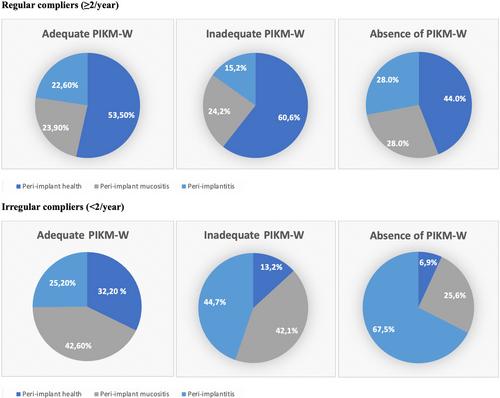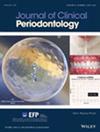To investigate the association, as well as to characterize the associated panel of pro- and anti-inflammatory markers, between the different components of the peri-implant phenotype and the presence of peri-implantitis/peri-implant soft-tissue dehiscence (PISTD).
A total of 324 implants in 112 patients were included. The following components of the peri-implant phenotype were clinically measured through the use of a manual periodontal probe or a digital calliper: keratinized mucosa width (PIKM-W), mucosal thickness (MT), attached mucosa (AM) and vestibulum depth (VD). The presence of peri-implantitis and PISTD was assessed through clinical and radiographic examination. Mixed-models logistic regression analyses were performed to analyse the association between peri-implant phenotype and the presence of peri-implantitis or PISTD, adjusting for relevant confounders. Multiplex immunoassays were employed to evaluate the peri-implant crevicular fluid levels of a panel of pro- and anti-inflammatory markers.
Peri-implant health, peri-implant mucositis and peri-implantitis were diagnosed in 36.6%, 21.4% and 42% of the patients (classified according to their worst implant) and 35.2%, 34.3%, and 30.5% of the implants, respectively. In the multi-level multiple regression model, the absence of PIKM-W (odds ratio [OR] = 9.24; 95% CI: 2.73–31.28), the absence of attached mucosa (OR = 19.58; 95% CI: 6.12–62.56) and a reduced (<4 mm) vestibulum depth (OR = 2.61; 95% CI: 1.05–6.48) were associated with peri-implantitis. Similarly, the absence of PIKM-W (OR = 6.32; 95% CI: 1.67–23.83), a thin (<2 mm) mucosa (OR = 157.75; 95% CI: 14.06–1769.9) and a reduced vestibulum depth (OR = 3.32; 95% CI: 1.02–10.84) were associated with the presence of PISTD. Implants with PIKM-W = 0 mm showed statistically significantly higher levels of interferon-γ in both regular (≥2 maintenance/year) and irregular (<2 maintenance/year) compliers (p = 0.046 and p = 0.012). In irregular compliers, the absence of PIKM-W was also associated with statistically significantly higher levels of interleukin (IL)-1β and IL-21 (p = 0.016, p = 0.046). These associations were independent of the effect of relevant confounders (e.g., plaque, compliance with maintenance, etc.).
Within their limits, the present findings indicate that (a) peri-implant soft-tissue phenotype appears to be associated with the presence of peri-implantitis and PISTD, and (b) in the absence of PIKM-W, the inflammatory response seems to be dysregulated and the soft-tissue remodelling up-regulated.



